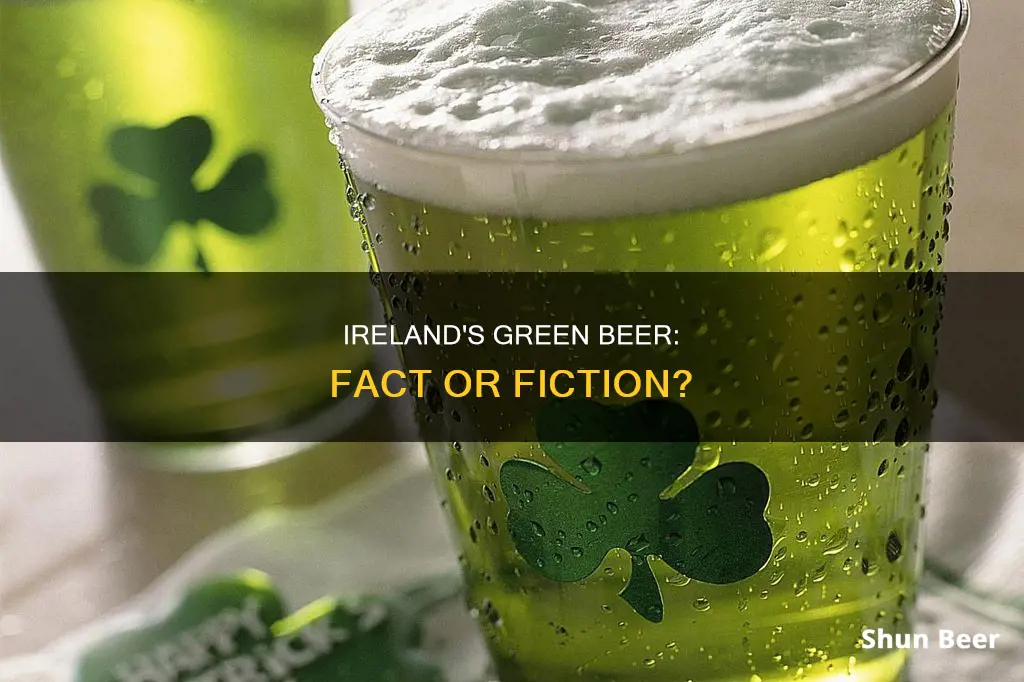
Green beer is a popular way to celebrate St. Patrick's Day, but despite being associated with Ireland, the tradition is not actually Irish. It is believed to have originated in the US in the early 20th century, with the first instance of green beer being served in New York in 1914. The drink is made by adding blue food colouring to beer, turning it green. While the tradition has spread internationally, it is not widely practised in Ireland, and some consider it to be culturally insensitive.
| Characteristics | Values |
|---|---|
| Is green beer drunk in Ireland? | No |
| Who drinks green beer? | Americans, and people in other countries with a large Irish diaspora |
| Why is green beer drunk? | To celebrate St. Patrick's Day |
| What is green beer made from? | Beer and blue food colouring |
| What is the origin of green beer? | It was first made by Dr Thomas Hayes Curtin in New York in 1914 |
What You'll Learn
- The tradition of drinking green beer on St. Patrick's Day is American, not Irish
- The first batch of green beer was created by a New York doctor in 1914
- The green colour came from laundry bleaching powder called 'wash blue'
- Green beer is usually made with cheap beer
- The tradition of drinking green beer is considered offensive by some

The tradition of drinking green beer on St. Patrick's Day is American, not Irish
The tradition of drinking green beer on St. Patrick's Day is not an Irish one. In fact, it is an American innovation. The first instance of green beer was created by a New York doctor, Thomas Hayes Curtin, in 1914. He served his creation at a St. Patrick's Day celebration at the Schnerer Club in the Bronx. The green colour came from a laundry bleaching powder known as "wash blue".
The tradition of drinking green beer on St. Patrick's Day is not a long-standing one. It did not catch on in the US until the 1950s. It is believed that the idea of green beer may have come from an article in the Spokane Press in 1910, which described a bar in Spokane, Washington, that was serving green beer. However, the bartender refused to reveal how it was made.
Green beer was originally associated with beer that was not ready to be consumed. The term green beer was used to describe beer that was too young or "green" and could make consumers sick. Beer companies even used this to their advantage, warning consumers about the dangers of drinking "green beer". So, it is quite ironic that people started drinking beer that was intentionally dyed green.
While the tradition of drinking green beer on St. Patrick's Day is not Irish, the colour green does have a connection to Ireland. In the 17th century, green became a symbol of unity for the Irish people in their struggle against oppressive English rule. It was also used to distinguish Catholics from Protestants, with Catholics being represented by green and Protestants by orange. Today, the Irish flag proudly displays both colours, with white in between to symbolise peace.
Although drinking green beer on St. Patrick's Day is not a traditional Irish custom, it has become a global phenomenon. It is just one of the many ways that people around the world celebrate St. Patrick's Day, which has evolved into a holiday that is less specifically Irish and more of a global celebration of Irish culture and heritage.
Beer and Paxlovid: Is It Safe to Drink?
You may want to see also

The first batch of green beer was created by a New York doctor in 1914
Green beer is not an Irish tradition, but an American one. The first batch of green beer was created by a New York doctor, Thomas Hayes Curtin, in 1914. Curtin created the green beer for a St. Patrick's Day celebration at the Schnerer Club in the Bronx. He used a laundry bleaching powder called "Wash Blue" to achieve the green colour, which was added to the beer in small quantities to avoid poisoning his guests.
The idea to dye beer green may have come from a mysterious article in the Spokane Press from March 17, 1910, which mentioned a bar in Spokane, Washington, serving green beer. However, the bartender refused to share how it was made.
While green beer is now often associated with St. Patrick's Day, the tradition is not originally Irish. In fact, the term green beer used to refer to beer that was too young and could make consumers sick. Interestingly, green was not always the colour associated with Ireland, and it became a symbol of unity for the Irish people during their struggle against oppressive English rule in the 17th century.
Today, green beer is typically made by mixing beer with blue food colouring, which combines with the natural yellow colour of the beer to create a green hue. While the tradition of drinking green beer on St. Patrick's Day is popular in the United States, it is not widely practised in Ireland or other parts of Europe.
Breaking into the Beer Industry: A Guide to Success
You may want to see also

The green colour came from laundry bleaching powder called 'wash blue'
The green beer tradition is not Irish at all but American. The first green beer was reportedly made in 1914 by Dr Thomas Hayes Curtin, a physician who made green beer for a St Patrick's Day celebration at the Schnerer Club in New York City. The secret ingredient in his concoction was a laundry whitener called "Wash Blue", an iron powder solution embedded with blue dye that was once used to brighten dingy whites.
The blue dye, when mixed with the natural yellow of the beer, turned the beer green. The addition of the blue dye was also in such a small quantity that it did not cause any illness in those who drank the beer. In fact, the term ""green beer" was previously used to refer to ""young" beer that had not been fully fermented and could make consumers sick.
The idea to dye beer green may have come from a mysterious article written in the Spokane Press in March 1910, which mentioned a bar in Spokane, Washington, that was serving green beer. However, the bartender's recipe for making it was not disclosed.
By the 1950s, green beer had become a mainstream symbol of St Patrick's Day, which was becoming less specifically Irish and more American. The tradition then spread internationally, with the Irish themselves being introduced to the drink made in their honour.
Light Beer and Dieting: Friend or Foe?
You may want to see also

Green beer is usually made with cheap beer
Green beer is not an Irish tradition. In fact, it is an American innovation that is usually consumed on St. Patrick's Day. The tradition is believed to have started in 1914 by Dr. Thomas Hayes Curtin, who added laundry whitener to beer to make it green. While the original recipe was potentially poisonous, today's green beer is made with food colouring.
Green beer is typically made with cheap beer. This is because green beer is ultimately a gimmick, and bars can sell low-quality beer for the same price as a nice pilsner. If you're looking for a higher-quality beer to drink on St. Patrick's Day, there are many Irish alternatives to choose from. For example, you could try a pint of Guinness, which has been brewed in Dublin since 1759, or a lager called Harp. Other notable Irish beers include Murphy's stout, Smithwick's Red Ale, and Sullivan's Irish ale.
While green beer may be a fun and festive way to celebrate St. Patrick's Day, it is not a tradition that is widely practised in Ireland. In fact, some sources suggest that it is mainly aimed at tourists and is not popular among the Irish themselves. Instead, St. Patrick's Day in Ireland is a more diplomatic affair, with government ministers travelling the world to discuss political issues and matters of peace.
So, if you're looking to celebrate St. Patrick's Day like the Irish, you may want to skip the green beer and opt for a higher-quality Irish brew. Cheers!
Freezing Beer: Safe to Drink After Thawing?
You may want to see also

The tradition of drinking green beer is considered offensive by some
The practice of drinking green beer is seen by some as a commercialisation and perversion of the true spirit of St. Patrick's Day, which is a religious holiday in Ireland. The day is celebrated with feasts held in honour of St. Patrick, where people are given a brief respite from their Lenten obligations, and drinking to excess is considered disrespectful.
Additionally, the use of green colouring in beer can be seen as problematic. While today, green beer is typically coloured with food dyes, the original green beer created by Dr. Thomas Hayes Curtin was coloured with a laundry whitener called "Wash Blue", which is now known to be poisonous.
Some also find the practice of drinking green beer to be in poor taste given the violent history of the Irish and the existence of Irish Car Bomb cocktails, which are considered culturally insensitive.
Furthermore, the commercialisation of St. Patrick's Day and the focus on drinking green beer is viewed by some as a perpetuation of Irish stereotypes and a distraction from the true meaning of the holiday, which is to celebrate Irish culture and identity.
Beer and Budesonide: Is It Safe to Mix?
You may want to see also
Frequently asked questions
No, drinking green beer is not an Irish tradition. It is an American one.
The tradition is said to have started in 1914 when Dr Thomas Hayes Curtin added laundry whitener to beer to make it green for a St. Patrick's Day celebration in New York.
No, Irish people do not drink green beer on St. Patrick's Day. It is considered a gimmick aimed at tourists.







